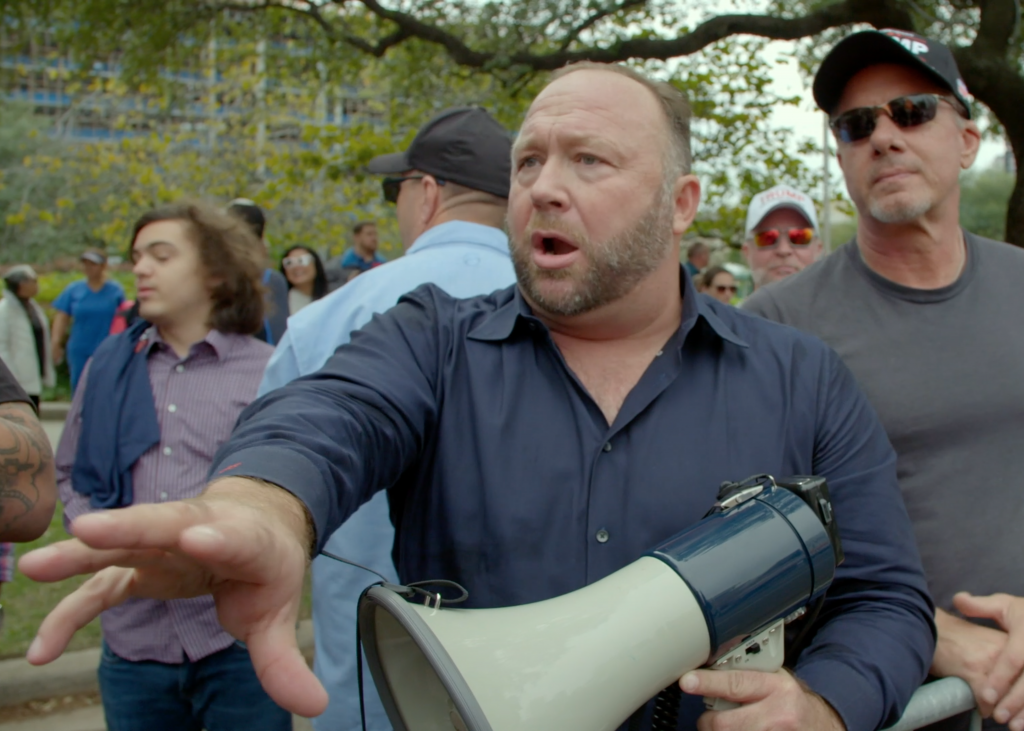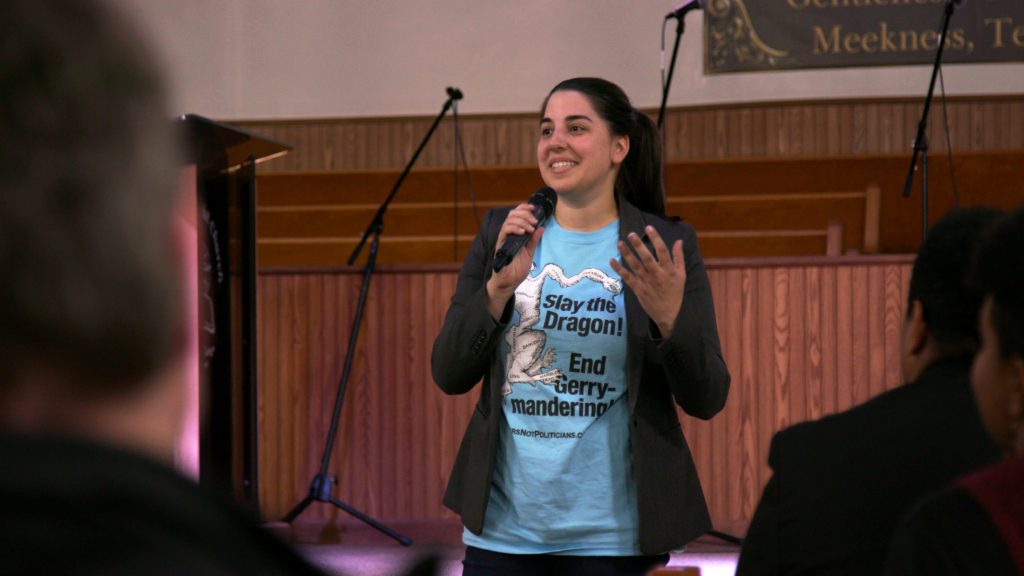March 20, 2020
by Carla Hay

“After Truth: Disinformation and the Cost of Fake News”
Directed by Andrew Rossi
Culture Representation: This politically oriented documentary, which examines the effects of “fake news” in the United States, interviews a predominantly white group of people, including mainstream media journalists, government officials, university professors, right-wing conspiracy theorists and victims of “fake news” stories.
Culture Clash: While the documentary mentions that false news reports can come from anywhere, the movie focuses primarily on “fake news'” spread by right-wing, anti-establishment conspiracy theorists, and the movie shows how this “fake news” affects the targeted people and journalists.
Culture Audience: This documentary will appeal mostly to people who are comfortable with mainstream media outlets as their main source of news, since these outlets are portrayed in the movie as the best watchdogs for “fake news.”

What is “fake news”? It depends on who you ask. In the documentary “After Truth: Disinformation and the Cost of Fake News,” what’s defined as “fake news” are false reports and lies that go viral and reach the mainstream. The movie, directed by Andrew Rossi, takes particular aim at right-wing conspiracy theorists as the purveyors of fake news that do the most damage. The documentary takes the position that mainstream media outlets, although flawed, are the still the best ways to combat fake news since they have the resources to fact-check stories. Meanwhile, the conspiracy theorists firmly believe that mainstream media outlets are the enemies and the real spreaders of fake news.
Tabloids have been publishing fake news for decades, but a more recent type of fake news has arisen through people in the general public using social media to spread their messages. “After Truth” takes an even narrower scope of this new type of fake news, by zooming in on politically motivated “fake news” stories (instead of tabloid staples such as celebrity gossip) that have occurred in the U.S. since 2015.
Why the year 2015? According to Georgetown University disinformation expert Molly McKew, who’s interviewed in “After Truth,” the summer of 2015 was the start of this current “fake news” era. And most of the experts interviewed think that it’s not a coincidence that this era started soon after Donald Trump began his campaign to become president of the United States. Although the documentary focuses mostly on Americans involved in the war of spreading and debunking fake news, there is some mention of Russian interference in the 2016 U.S. presidential election.
“After Truth” puts a spotlight on some of the biggest “fake news” scandals in recent years, starting with the hysteria created in the summer of 2015 from Jade Helm 15, an eight-week military exercise in Bastrop County, Texas. The exercise was intended to train military personnel on what do in wartime, including re-enactments. Somehow, false stories began spreading on the Internet that the military was really there to detain people who were known to speak out against then-President Barack Obama, and that the military was really there to enforce “martial law.”
The documentary shows angry citizens at a crowded town hall meeting expressing disbelief and fear when a military official at the meeting assured them that the stories were fake and that no one was going to be arrested for their political beliefs. Paul Pape, a judge in Bastrop County, was one of the people who had to deal with the flood of backlash from misinformed people who were panicking over the military presence. In the documentary, Pape made it clear in saying what he learned from the experience: “Social media is the devil.”
Perhaps the most extreme case that’s spotlighted in the documentary is Pizzagate, the conspiracy theory that began in 2016 about Comet Ping Pong, a family-oriented pizza parlor/ping-pong facility in Washington, D.C., that’s frequented by many people who work in politics. One of the customers was John Podesta, a former White House chief of staff and chair of Hillary Clinton’s 2016 U.S. presidential campaign.
After several of Podesta’s personal email messages were hacked and leaked on WikiLeaks, the email showed that he was a customer of Comet Ping Pong. Conspiracy theorists (the documentary names Infowars founder Alex Jones as a chief culprit) took the information in the email and twisted it into the Pizzagate theory that Comet Ping Pong was a secret meeting place for a pedophile ring. Podesta, Clinton and billionaire George Soros (a high-profile supporter of Clinton and other liberal Democrats) were all named by the Pizzagate conspiracy theorists as being perverted participants in the ring.
In December 2016, one of the conspiracy theorists (a then-28-year-old armed gunman) was so agitated by this belief that he drove about 350 miles from North Carolina, burst into Comet Ping Pong, and started shooting. Luckily, no one was injured or killed, thanks to employees who quickly evacuated customers from danger. The gunman was arrested and sentenced to four years in prison in 2017. In 2019, another man, also identified as another right-wing conspiracy theorist, tried to set fire to Comet Ping Pong. He was also arrested.
In the documentary, Comet Ping Pong owner James Alefantis (who says the Pizzagate theories are all lies) and some of his employees give emotionally compelling accounts of the terror they felt the day of the shootout and the underlying threat of violence that they still feel, since they know that Comet Ping Pong is still a target for conspiracy theorists’ hatred. Alefantis says that he and Comet Ping Pong associates frequently get death threats and hate mail.
Alefantis, who is openly gay and has a LGBTQ-inclusive policy for customers and employees, also believes that homophobia is probably fueling some of the violent threats against his business. And he also talks about how he thought about closing the business many times, but because of the loyal support of his customers and employees, he’s vowed not to cave in to the bullying and death threats. “It’s a simple recipe,” he says of why Comet Ping Pong is still in business. “Family, community, truth. That’s why we’re here.”
“After Truth” also interviews several right-wing conspiracy theorists to show that they seem to care more about money and fame than reporting facts. They include political operative Jerome Corsi (who’s described in the documentary as the godfather of the current “fake news” era), Republican lobbyist Jack Burkman, Derrick Broze of the Conscience Resistance Network, and Jason Goodman of Crowdsource the Truth. None of them has a background in journalism—and they’re proud of it. As Goodman says in the documentary, “Whatever you think is journalism, I think of as fucked up.”
Burkman freely admits that fake news is “a political weapon,” yet he and others just like him don’t think they bear any responsibility for firing the weapon. “Yeah, there are terrible, negative consequences, but so what?” He adds with a smirk, “Let the people judge, despite the dangers. There is no reality, only perception.”
In the midst of the documentary’s very heavy subject matter comes some comic relief about how fake news can be bungled. Toward the end of the film, there’s a behind-the-scenes look at a debacle that was spearheaded by Burkman and fellow right-wing conspiracy theorist Jacob Wohl. In October 2019, the two men claimed that a woman had come forward with a sexual-assault accusation against United States Department of Justice special counsel Robert Mueller, who at the time was heading the investigation into Donald Trump’s 2016 presidential campaign. Burkman and Wohl promised that they and the woman would be at a press conference to give more details.
Although Burkman and Wohl went through with the press conference, the “mystery woman” never came forward. The press conference and the alleged sexual-assault claim were largely exposed as hoaxes. The documentary shows how, even after being confronted by angry and skeptical reporters, Burkman and Wohl tried to talk their way out of their inconsistent and contradictory statements. And after the press conference, Wohl seemed mostly concerned about whether or not they were “trending” on social media.
That “fake news” fiasco fortunately did not end in violence. But the effects of fake news on threatening people’s safety, as well as how it often crosses the line into hate speech, have led to growing backlash against conspiracy theorists. The documentary mentions that people like Infowars founder Jones (who’s now been banned from all major social media, such as Facebook, Twitter and YouTube) have no qualms about spreading false/questionable information about others, but are very thin-skinned if they think the same thing is being done to them. There’s footage of Jones, after he lost much of his income due to being banned by these social-media platforms, angrily confronting CNN senior media reporter Oliver Darcy and accusing CNN of spreading lies about him.
“After Truth” doesn’t let all mainstream media off the hook. Many of the people interviewed in this documentary say that social-media giants such as Facebook, Twitter and YouTube are corporate enablers of fake news and only try to stop to fake news when there’s widespread public backlash or a government investigation. Smaller social-media platforms such as Reddit and 4Chan are also mentioned as places that spread a lot of fake news and thrive on it. However, Facebook is singled out in the documentary as the worst corporate enabler of fake news.
Recode co-founder Kara Swisher says of Facebook’s relationship with fake news: “They created the platform where it gets spread and then they’re like, ‘Oh, what can we do?’ They hide behind the First Amendment, and they are not the government. They can make choices. They just don’t want to.”
Although many conspiracy theorists and spreaders of fake news who’ve been kicked off mainstream social media say that they are being “censored,” the documentary points out, for people who are ignorant about censorship, that censorship is when the government, not a business, stops or prevents free speech.
Also covered in “After Truth” is the conspiracy theory (which has been widely debunked) that Clinton had something to do with the 2016 murder of Seth Rich, a Democratic National Committee employee. Police have reported the case as a murder that happened during an attempted robbery. Seth Rich’s older brother Aaron is interviewed in the documentary to reveal how much damage (death threats and other harassment) that conspiracy theorists have caused to his family.
And although the documentary shows extreme right-wingers as being the worst offenders in spreading fake news, the movie gives just one example of a liberal who freely admitted to spreading fake news to get a Democrat elected in the 2017 contentious and controversial race for U.S. Senator in Alabama. The opponents were Roy Moore (a conservative Republican) and Doug Jones (a liberal Democrat). LinkedIn founder Reid Hoffman said he created fake accounts on social media, pretending to be right-wing supporters of Moore, so that they would alienate moderate Republicans and spur the moderates to vote for Doug Jones. (Doug Jones won the election.)
Hoffman says he has no regrets about spreading fake news: “I felt empowered to give Republicans a taste of their own medicine.” However, Doug Jones (who’s interviewed in the documentary) expresses disgust that anyone used fake news to help his campaign, and he condemns these tactics. Doug Jones says, “Two wrongs don’t make a right. That’s crazy.”
There are several journalists (all from mainstream media) who are interviewed in the documentary, including CNN’s Darcy; BuzzFeed media editor Craig Silverman; Washington Post reporter Keith Alexander; and The New York Times reporters Adam Goldman and Elizabeth Williamson. University professors interviewed include Kathleen Hall Jamieson, director of the Annenberg Public Policy Center at the University of Pennsylvania, as well as Yokai Benkler of Harvard University’s Berkman Klein Center, who has this to say about fake news: “It’s very clear what you have is a propagandist effort trying to achieve a result.”
On the one hand, this documentary does an excellent job of showing the real and very human collateral damage that can result in “fake news.” On the other hand, in its zeal in singling out conspiracy theorists as the worst of the worst, “After Truth” could have been a little more balanced in showing that mainstream media outlets can report false stories too.
The executive producers of “After Truth” include CNN’s Brian Stelter, and so that’s perhaps why the documentary turns a blind eye to all the political “fake news” that mainstream media outlets like CNN and The New York Times have ended up having to retract or correct since 2015. However, the difference between these mainstream media outlets and the conspiracy theorists is that when mainstream media outlets have been exposed as reporting false information, they usually admit their mistakes and make the necessary corrections or retractions. Conspiracy theorists almost never correct or retract statements that have been proven to be false, even if they’ve been sued over these false statements.
Whether people are politically liberal, conservative or somewhere in between, the main takeaway from “After Truth” is that in this digital technology age where it’s easier than ever before for people to have false online identities, manipulate photos and videos, and create “fake news,” it’s up to news audiences to be more pro-active in finding out the truth instead of believing stories at face value.
HBO premiered “After Truth: Disinformation and the Cost of Fake News” on March 19, 2020.

